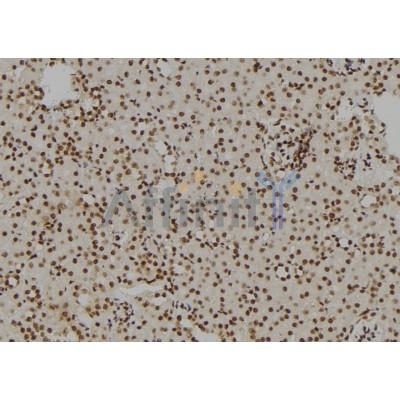GATA1 Antibody - #AF6184
Product Info
*The optimal dilutions should be determined by the end user.
*Tips:
WB: For western blot detection of denatured protein samples. IHC: For immunohistochemical detection of paraffin sections (IHC-p) or frozen sections (IHC-f) of tissue samples. IF/ICC: For immunofluorescence detection of cell samples. ELISA(peptide): For ELISA detection of antigenic peptide.
Cite Format: Affinity Biosciences Cat# AF6184, RRID:AB_2835067.
Fold/Unfold
Anemia, X-linked, without thrombocytopenia, included; ERYF 1; Eryf1; Erythroid transcription factor; Erythrold transcription factor 1; GATA 1; GATA binding factor 1; GATA binding protein 1 (globin transcription factor 1); GATA binding protein 1; GATA-1; GATA-binding factor 1; GATA1; GATA1_HUMAN; GF 1; GF-1; GF1; Globin transcription factor 1; NF E1; NF E1 DNA binding protein; NF-E1 DNA-binding protein; NFE 1; NFE1; Nuclear factor erythroid 1; Transcription factor GATA1; XLANP; XLTDA; XLTT;
Immunogens
A synthesized peptide derived from human GATA1, corresponding to a region within the internal amino acids.
- P15976 GATA1_HUMAN:
- Protein BLAST With
- NCBI/
- ExPASy/
- Uniprot
MEFPGLGSLGTSEPLPQFVDPALVSSTPESGVFFPSGPEGLDAAASSTAPSTATAAAAALAYYRDAEAYRHSPVFQVYPLLNCMEGIPGGSPYAGWAYGKTGLYPASTVCPTREDSPPQAVEDLDGKGSTSFLETLKTERLSPDLLTLGPALPSSLPVPNSAYGGPDFSSTFFSPTGSPLNSAAYSSPKLRGTLPLPPCEARECVNCGATATPLWRRDRTGHYLCNACGLYHKMNGQNRPLIRPKKRLIVSKRAGTQCTNCQTTTTTLWRRNASGDPVCNACGLYYKLHQVNRPLTMRKDGIQTRNRKASGKGKKKRGSSLGGTGAAEGPAGGFMVVAGGSGSGNCGEVASGLTLGPPGTAHLYQGLGPVVLSGPVSHLMPFPGPLLGSPTGSFPTGPMPPTTSTTVVAPLSS
Predictions
Score>80(red) has high confidence and is suggested to be used for WB detection. *The prediction model is mainly based on the alignment of immunogen sequences, the results are for reference only, not as the basis of quality assurance.
High(score>80) Medium(80>score>50) Low(score<50) No confidence
Research Backgrounds
Transcriptional activator or repressor which probably serves as a general switch factor for erythroid development. It binds to DNA sites with the consensus sequence 5'-[AT]GATA[AG]-3' within regulatory regions of globin genes and of other genes expressed in erythroid cells. Activates the transcription of genes involved in erythroid differentiation of K562 erythroleukemia cells, including HBB, HBG1/2, ALAS2 and HMBS.
Highly phosphorylated on serine residues. Phosphorylation on Ser-310 is enhanced on erythroid differentiation. Phosphorylation on Ser-142 promotes sumoylation on Lys-137 (By similarity).
Sumoylation on Lys-137 is enhanced by phosphorylation on Ser-142 and by interaction with PIAS4. Sumoylation with SUMO1 has no effect on transcriptional activity (By similarity).
Acetylated at 2 conserved lysine-rich motifs by CREBBP in vitro. Acetylation does not affect DNA-binding in vitro but is essential to induce erythroid differentiation and for binding chromatin in vivo (By similarity). Acetylated on Lys-233, Lys-245 Lys-246 by EP300.
Nucleus.
Erythrocytes.
The two fingers are functionally distinct and cooperate to achieve specific, stable DNA binding. The first finger is necessary only for full specificity and stability of binding, whereas the second one is required for binding (By similarity).
Restrictive clause
Affinity Biosciences tests all products strictly. Citations are provided as a resource for additional applications that have not been validated by Affinity Biosciences. Please choose the appropriate format for each application and consult Materials and Methods sections for additional details about the use of any product in these publications.
For Research Use Only.
Not for use in diagnostic or therapeutic procedures. Not for resale. Not for distribution without written consent. Affinity Biosciences will not be held responsible for patent infringement or other violations that may occur with the use of our products. Affinity Biosciences, Affinity Biosciences Logo and all other trademarks are the property of Affinity Biosciences LTD.
